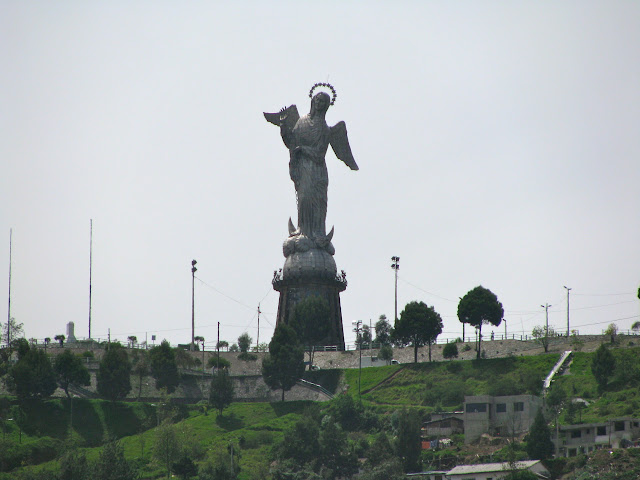The ornate wooden ceiling is made of interlocking geometrical pieces.
A glimpse of the main altar, a spectacular example of baroque carving.
Next to the church is a museum which contains some of the church’s finest artwork, not to mention a beautiful courtyard.
The small ever-visible hill to the south of the Old Town is called El Panecillo (Little Bread Loaf), a major landmark in Quito. It’s topped by a huge statue of La Virgen de Quito and offers marvelous views of the whole city and surrounding volcanoes.
See what we mean? It's the perfect spot to observe Quito’s two distinct districts: the Old Town (in front) and the New Town (in the background).
A little boy enjoys a street musician playing traditional songs.
We take a walk along the restored Calle La Ronda. Once the city’s red light district and home to poets, painters and troubadours, it now has a series of at galleries, workshops and some of the city’s best restaurants.
The Jesuit church, La Compañia de Jesús, is one of the great baroque masterpieces in South America. All the work took 160 years (1605-1765) to complete. The facade doesn’t fail to impress with it’s unbelievable detailed carvings.
Onto Plaza Grande and Quito’s somewhat austere main cathedral from the 16th century. Although not as ornate as many of Quito’s other churches, it houses intriguing works from the Quito School (indigenous artists trained by Europeans working from the 16th to 18th century).
A painting of the Last Supper with Christ and his disciples feasting on Ecuadorian cuisine: cuy (roast guinea pig), chicha (a fermented corn drink) and humitas (corn dumplings).
Seen in the distance is The Basilica del Voto Nacional, modeled on Paris’s Notre-Dame.
We are moved by the powerful paintings of the famous Ecuadorian painter, Oswaldo Guayasamin after a tour of his museum. His humanist work, marked as expressionist, reflects the pain and misery that the larger part of humanity has endured, and denounces the violence that every human being has had to live with in the 20th century marked by world and civil wars, genocide, concentration camps, dictatorships and tortures.
The heart and soul of Quito’s nightlife, the Mariscal district has been dubbed “Gringolandia” by those who flock to the area to drink and dance the night away with the city’s tourists and resident foreigners. Here’s what it looks like from the window of the trendy and modern, Nu House Hotel, in the heart of the action on Plaza Foch, where we spend a night.
A day trip from Quito is the colourful Otavalo market, where traditionally dressed indigenous people sell handicrafts to hordes of foreigners who pour in every Saturday to get in on the deals.
We opt to go on Wednesday to avoid the crowds and Tim succumbs to a $15 (should have been $10) Panama hat.
A lunch stop at Peguche Waterfall.
Our driver takes us to a local family of weavers and we decide a wall hanging made by this lady’s husband would look good on the wall of our home in Whistler.
One of the most common souvenir photos taken in Ecuador is that which has a visitor with one foot in either hemisphere, straddling the Equator, here at the Quitsato Mitad del Mundo Monument.


































No comments:
Post a Comment